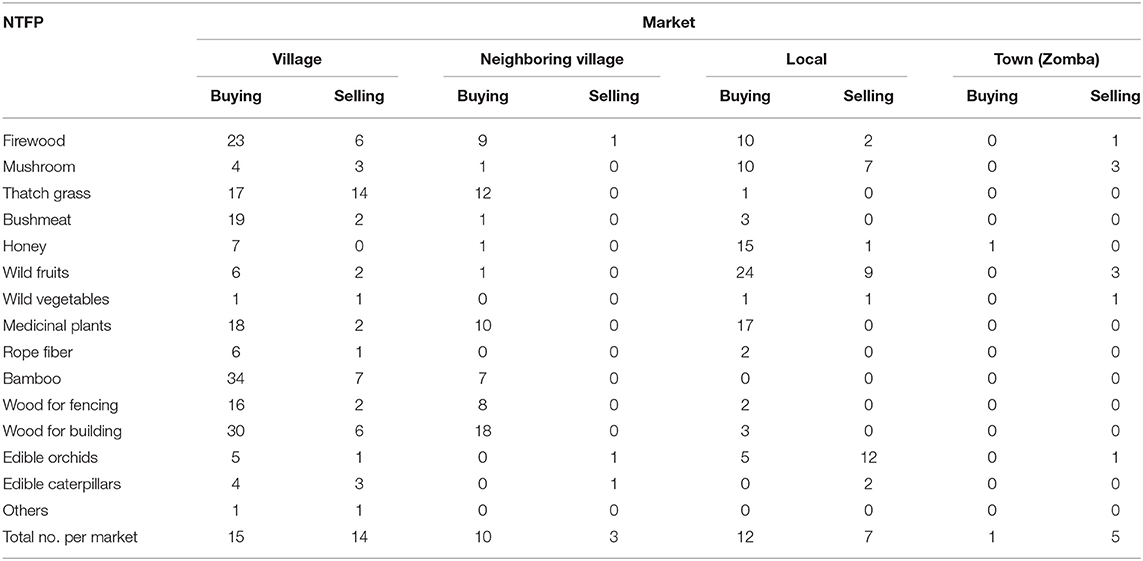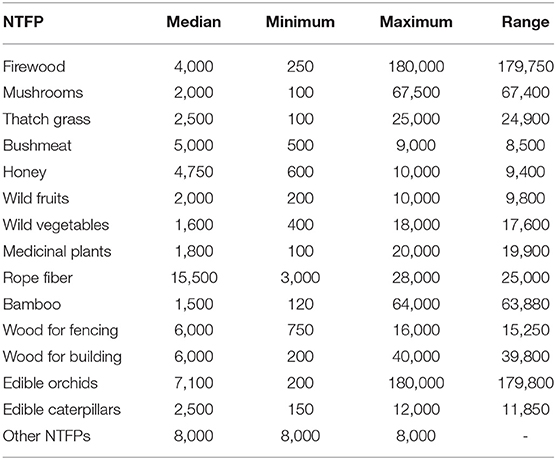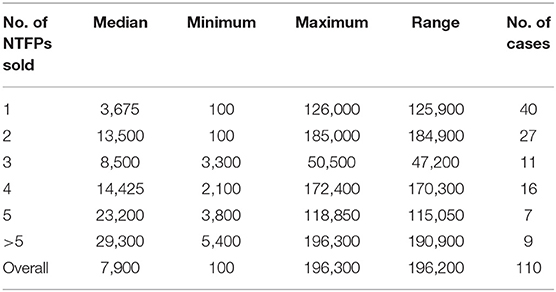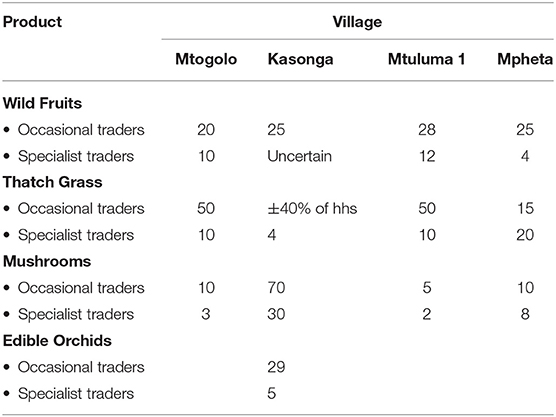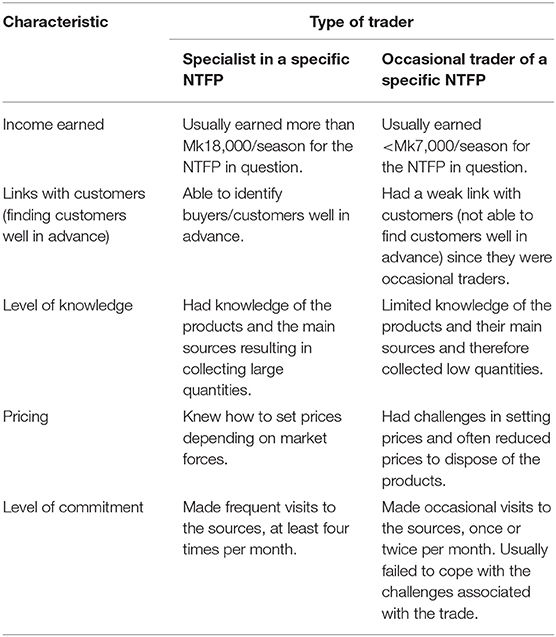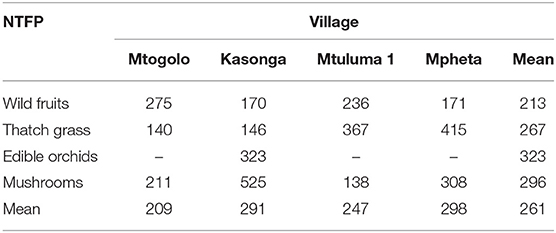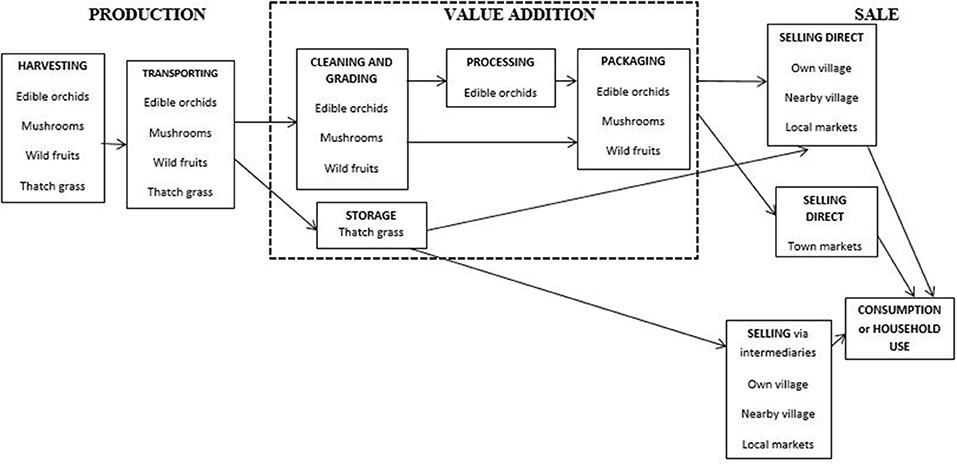- 1Department of Environmental Science, Rhodes University, Grahamstown, South Africa
- 2Department of Geography, King's College London, London, United Kingdom
The importance of non-timber forest products (NTFPs) to rural livelihoods is widely acknowledged globally, as is the income generated from casual or fulltime trade on village and urban markets. However, there is less understanding of how the condition or status of the neighboring landscapes influence the use of and trade in NTFPs. Here we report on the use and trade in NTFPs in four villages situated along a gradient of decreasing forest cover in southwest Malawi using a mixed-methods approach. Data were sourced via a survey of 286 households, value chain analysis of the four most commonly traded NTFPs (thatch grass, edible orchids, mushrooms, and wild fruits), key informant interviews with NTFP traders and direct observations. All households used at least one NTFP, with the most widely used being firewood (100% of households), bamboo (96%), thatch grass (94%), and timber for construction (92%). Overall, 15% of households sold at least one NTFP and the prevalence of selling within a village was correlated with forest cover, whereas buying of NTFPs was inversely correlated with forest cover. There was a wide range in mean annual income (US$20–456) from selling NTFPs based on the product, whether the trader sold on a casual or full-time basis and the market. Of those households selling NTFPs, approximately two-thirds sold more than one NTFP product, which is rarely recognized in income studies of individual market chains. The returns to labor were variable between villages and products, but were generally double or more than the national minimum hourly wage. The NTFP value chains were short, dominated by traders and some intermediaries. Most of the products were sold in local markets with little value addition. Overall, NTFPs were an integral part of the household economy, with multiple participants and users, partly shaped by the forest cover of the surrounding landscapes.
Introduction
It is well established that non-timber forest products (NTFPs) contribute in various ways to the well-being of many rural and urban households and populations around the world (Angelsen et al., 2014; Shackleton and Pullanikkatil, 2018). Valuation of the tangible contributions via household provisioning and trade indicate that income shares from NTFPs vary within and between communities and regions, and range from just a few percent to over 50% (Vedeld et al., 2007; Angelsen et al., 2014). Broad patterns, albeit with exceptions, indicate the income contributions are often highest amongst the poorest households and communities, large households, and those in more remote settings (Shackleton, 2015). There is also growing evidence that local and wider-scale commercialization of NTFPs is increasing in many regions, providing cash income to numerous households (Welford and le Breton, 2008; Cunningham, 2011).
There has been a longstanding interest in commercialization of NTFPs from different disciplines as, on the one hand, a vehicle for poverty alleviation, and on the other hand, a dynamic process with the risk of driving unsustainable resource use practices. Which of these outcomes is more likely is context specific and is also a function of scale of the market (Wynberg and van Niekerk, 2014). Products that are sold on national and international markets gather more attention from government and development agencies because typically they can engage a lot of people, have a long market chain with a variety of stages, skills required, actors, some degree of specialization, and perhaps value addition (Marshall et al., 2006a; Wynberg and van Niekerk, 2014). In contrast, local markets are often overlooked by government and development agencies because they are characterized by the very opposite (Shackleton et al., 2007, 2008). However, what they may lack in length and value of the market chain, they often make up in the sheer number of participants and transactions (Shackleton et al., 2007). Thus, there is a greater need to both understand the nature and dynamics of local markets, as well as foster environments and policies that will support them and the underlying sustainability of the NTFPs on which they are based (Shackleton and Pandey, 2014).
There is some insightful literature on the barriers or constraints to commercialization of NTFPs (Welford and le Breton, 2008; Heinen and Shrestha-Acharya, 2011; Putzel et al., 2015), most often those in higher-scale markets, as well as at specific stages along the market chain. Analysis along the market chain may also reveal bottlenecks or inequities at specific points or nodes (Marshall et al., 2006a; Bolwig et al., 2011; Ingram et al., 2014). Nkem et al. (2010) note that for longer chains the distribution of market revenue can leave local people with proceeds lower than the value of the commodity, while wholesalers and retailers get most of the benefits and profit (Wynberg and van Niekerk, 2014). Securing a fair market for NTFPs is not achievable in some settings due to obstacles faced by subsistence farmers, local processors and traders (Marshall et al., 2006a), including inadequate capacity to produce and access markets, lack of information, poor road networks, lack of access to reliable, and cheap transport and corruption practices or bribery (Marshall et al., 2006a; Shackleton et al., 2007; Awono et al., 2010; Nkem et al., 2010; Saha and Sundriyal, 2012).
The market chain concept has been adopted from agricultural and institutional economics and applied to a wide diversity of NTFP enterprises (Belcher, 1998), such as honey in the Phillippines (Matias et al., 2018), frankincense in Sudan (Abtew et al., 2012), palm fruits in Brazil (De Sousa et al., 2018), and spice in Cameroon (Ndumbe et al., 2019). The terms supply chain and market chain are used synonymously (Neumann and Hirsch, 2000). Market chains describe the several links that connect all the actors and transactions involved in the movement of NTFPs from the source to the final consumer, unveiling a sequence of stages through which a product is bought and sold from the harvesters, processors, and traders, up to the final consumers (Belcher, 1998; Lundy et al., 2008). A value chain analysis helps to describe markets for NTFPs and assess how well the market chain is working (Kaplinsky and Morris, 2000; Marshall et al., 2006b; te Velde et al., 2006). A value chain approach is a diagnostic tool that guides the identification of the actors within the chain, and the share of the final price or value that each secures. It is helpful because it fosters an understanding of why poor participants may not benefit optimally from their productive activities and what can be done to improve the distributional outcomes of their participation (Mitchell et al., 2011; Wynberg and van Niekerk, 2014). Though most NTFP markets require few capital inputs, for many, especially in local markets, trading them tends to have low returns per unit (te Velde et al., 2006). Reasonable incomes are more likely to be achieved if high volumes are traded, which requires capital to buy, store and to transport the products (te Velde et al., 2006). However, there are exceptions, such as where the trade is in sought after niche items, such as cultural or high-value artistic artifacts, or where a third party agency helps promote fair and ethical trade or where national or export markets are tapped.
Market chain characteristics are shaped by local and broader contexts. To date the focus has been on the social, governance, and economic contexts (Wynberg and van Niekerk, 2014), with little consideration of how the prevailing biophysical context and dynamics may influence the types of NTFPs marketed as well as the nature of the market chain. A crucial biophysical context is likely to be the extent and quality of the surrounding environments from which the NTFPs are harvested. A fragmented or declining environmental quality is likely to support lower populations and produce lower yields of some NTFPs and simultaneously affect what land use and livelihood options might be viable or not. For example, deforestation and lower tree cover have been associated with declines in consumption and diversity of nutritious fruits and wild foods (Ickowitz et al., 2013), even in the study site of this work (Maseko et al., 2017). Bushmeat consumption has also been correlated positively with tree cover in the central Amazon, although bushmeat hunting is more widespread in fragmented forests (Torres et al., 2018). Deforestation is pervasive in Malawi (Bandyopadhyay et al., 2011; Meijer et al., 2016) and many other countries, but there has been little systematic examination of how it affects the supply of NTFPs, other than firewood (e.g., Bandyopadhyay et al., 2011), and consequently the income share to households from the use or marketing of NTFPs. To help address this gap, this study sought to determine the use and trade of selected NTFPs and their value chains and benefits to households along a deforestation gradient. We considered the following research questions: (1) What types of NTFPs are used and preferred at household level? (2) What types and quantities of NTFPs are marketed? (3) What value addition is done along the chain? (4) How much income is generated from NTFP trade? and (5) How does local deforestation status influence any of these?
Study Area
The study was done in four villages in the Zomba District, southern Malawi, as part of a larger study examining ecosystem services trade-offs [“Attaining Sustainable Services from Ecosystems through Tradeoff Scenarios” or ASSETS (Poppy et al., 2014)]. The four sites were selected along a gradient of woody vegetation cover and deforestation from Lake Chilwa in the east, through and beyond the Zomba forest reserve in the west (Table 1). The catchment is undergoing significant land transformation, especially with respect to loss of natural forests and woodlands (Pullanikkatil et al., 2019). Land use and cover images showing changes between 1990 and 2010 were used to make this categorization. The topography of Zomba district is characterized by mountainous and hilly regions of the Zomba plateau which forms the ridge dividing the upper Shire Valley in the western part of the district, from the broad plains of Lake Chilwa in the east. Elevation ranges from 2 085 m above sea level on the Zomba plateau to 627 m at Lake Chilwa.
Zomba District experiences a tropical climate with three main seasons; cold dry (April–July), hot dry (August–October), and hot wet (November–March). The hottest months are September to November with average temperatures ranging between 28 and 30°C. June and July are the coldest months, with minimum temperatures of ~10°C. The annual rainfall varies between 600 and 1 500 mm (1999–2005), with February as the wettest month. The eastern side of Zomba Mountain falls on the windward and receives more rainfall than the western side of the plateau (GoM, 2009).
The economy of Zomba District is agro-based, with maize production for subsistence and sale being the most common crop, along with tobacco as a cash crop in some areas (Zomba District Assembly 2009). Other common crops include rice, cassava, potatoes, beans and pigeon peas. Livestock production is mainly for subsistence, based on cattle, goats, pigs and poultry (GoM, 2009). The population density within the district is ~231 persons per km2. Formal employment is limited, and 24% of adult males, and 28% of females in the district are illiterate (UN-HABITAT 2011). Poverty is widespread in the district, with about 70% of the population falling below the national poverty line and almost 200,000 living in extreme poverty (GoM, 2009). Zomba is one of the three poorest districts in Malawi.
Methods
A mixed-methods approach was used to generate information to address the research objectives, consisting of a quantitative household survey, village and trader focus group discussions, trader interviews, and value chain analysis. Most of the data were collected in the second half of 2014. This study comprised part of the broader ASSETS project for which ethics approval was provided from the University of Southampton's Ethics Committee (Ref 8717). Additionally, this study was carried out in accordance with the research ethics guidelines of Rhodes University and approved in advance by the then ethics committee of the Dept of Environmental Science. Written informed consent was provided by those who were literate, and verbal consent (recorded) for illiterate respondents; both consent procedures were approved by the Rhodes University committee.
Household Use and Extent of General Trade in NTFPs
A random survey of 47% of the households in each village (n = 286 in total) was conducted to collect information at household level on the NTFPs used, bought, or sold and the quantities sold in time periods defined by the respondent (e.g., per week, month, season, year). The household survey also captured household demographic data pertaining to the number of people in the household, education levels, ages and the like.
Value Chain Analyses
A value chain analysis was undertaken for the four most commonly traded NTFPs reported in the household survey. These were mushrooms (“Bowa” comprising Ascomycota spp. and Basidiomycota spp.), wild fruits (mostly “Masuku”; Uapaca kirkiana), but at times also small quantities of other species), thatch grass (“Udzu”; Hyparrhenia hirta), and edible orchids (“Chikande” comprising Disa robusta, D. zombica and Satyrium ambylosaccos). The first three were collected and traded in all four study villages. Edible orchids were only found around Kasonga, but the majority of the households (64%) were involved in their trade to some degree.
A range of methods were used to understand the structure and dynamics of the value chains in each village. First, focus group discussions (FGDs) were held separately with a group of traders for each of the four selected NTFPs in each village, resulting in a total of 13 focus groups. A trader was regarded as an individual who was involved in both harvesting and selling NTFPs. The FGD participants were mainly identified through the household survey, but in some instances snowballing was used to identify additional traders. This was necessary because some households traded in multiple products and we wished to avoid involving them in two or three FGDs. The FGDs were guided by a checklist of questions aimed at understanding what motivated traders to participate in NTFP trade, the sources of the products, and the value chain for the product. Each FGD produced a value chain diagram for the specific NTFP. Second, 64 interviews were conducted with NTFP traders individually (21 wild fruit traders, 18 mushrooms, 20 thatch grass, 5 edible orchids), and with four Department of Forestry staff (two Forestry Assistants, a District Forestry Officer and one Patrol Officer). A ranking matrix was used to identify the most important characteristics that influenced households to choose the NTFP that they opted to sell. All focus groups and key informant interviews were recorded in writing together with voice recordings after obtaining verbal, informed consent from the participants (as many were illiterate). Lastly, direct observations were used to appraise the distance to NTFP collection areas, time spent to gather the NTFPs, and selling patterns in the markets. At the time of field work the exchange rate between the Malawian Kwacha and the US dollar was 395:1.
Data Analysis
The quantitative data obtained from the household survey were coded and analyzed using Statistical Package for Social Science (SPSS) version 16.0. Descriptive statistics were used to calculate frequencies, percentages, means, and medians. If the data did not meet the conditions of parametric testing then non-parametric tests were used. Cross-tabulations were also used with some variables statistically tested using the Pearson's Chi-Square analysis to discover if there was any significant relationship between two categorical variables. The qualitative data were analyzed using thematic analysis. First, the data were transcribed; this involved typing up the field notes with supplementary information from the recordings. The data analysis involved reading, examining and identifying passages of the text that were linked by a common theme. This allowed categorization of the information and establishment of a framework of thematic ideas which addressed the research objectives and questions (Gibbs, 2007). Similarities and differences were analyzed between different products and villages.
Results
NTFP Use, Acquisition and Selling
All 268 sample households used more than one NTFP, with all households using firewood as a source of cooking fuel (Table 2). More than 75% of the households used one or more of thatch grass, wild fruits, wild vegetables, medicinal plants, rope fiber, bamboo, wood for building, and wood for fencing. The proportion of households using specific NTFPs varied between the villages (Table 2). All households within Mtogolo used at least six products namely; firewood, thatch grass, wild fruits, wild vegetables, rope fiber, and bamboo. Three products (firewood, wild vegetables, and wood for building) were used by all households in Kasonga village while a further eight products were used by more than 80% of the households. In Mtuluma 1 village all interviewed households used at least six products. In contrast, Mpheta village had only one product (firewood) used by all households, and only three other products used by more than 80% of households; thatch grass, bamboo, and wood for building. This was significantly lower than the other three villages (F = 4.60; p < 0.01).
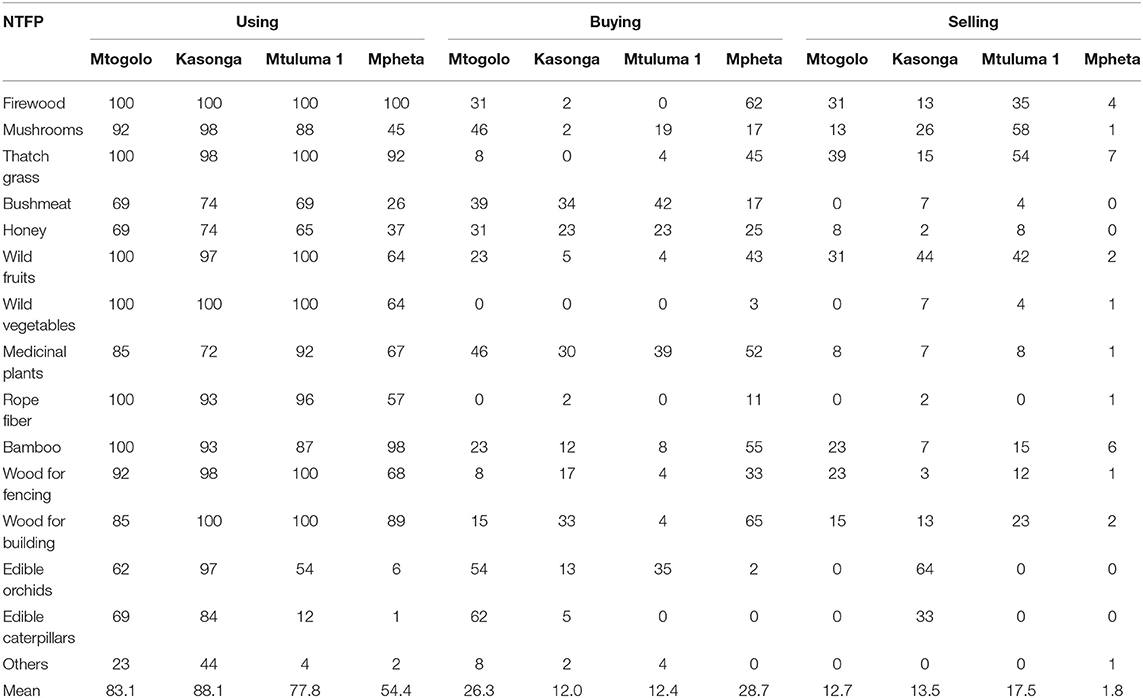
Table 2. Proportion (%) of households (n = 268) using, buying, or selling different NTFPs in four villages.
The majority (89%) of the households bought at least one NTFP. The products were bought from various markets within the villages and further afield. The most widely purchased NTFPs were building timber, medicinal plants, firewood, and bamboo (Table 2). Mpheta village had the highest proportions of households buying nine of the 15 NTFPs listed, Mtogolo five, and Mtuluma 1 one (bushmeat). Overall, there was a significant difference (F = 3.52; p < 0.05) with a higher proportion of households in Mpheta and Mtogolo purchasing NTFPs than in Kasonga and Mtuluma 1, which were not significantly different to one another.
A smaller but significant proportion (39%) reported selling one or more NTFPs, ranging from very ad hoc trade to regular trade that provided a meaningful contribution to the household income. More than 10% of households were involved in selling firewood, mushrooms, thatch grass, wild fruits, and edible orchids (Table 2). Kasonga had the largest proportion of households selling bushmeat (44%), wild fruits (8%), wild vegetables (7%), rope fiber (2%), edible orchids (64%), and edible caterpillars (33%). Edible orchids were only traded by Kasonga households due to the availability of the orchids in the area. Mtuluma 1 had a larger proportion of households trading firewood, mushrooms, thatch grass, and wood for building than any other village. Comparisons between villages showed a significant effect in mean percentage selling per NTFP (F = 3.45; p < 0.05). Post-hoc testing showed Mpheta was significantly lower than the other three, which were not significantly different to one another. Overall, the mean use and selling were the lowest in Mpheta village. In contrast, mean buying was the highest in Mpheta.
General Household Buying and Selling of NTFPs
Selling of NTFPs was done in various markets (Table 3). Eight products were sold only within village markets, namely thatch grass, bushmeat, medicinal plants, rope fiber, bamboo, wood for fencing, wood for building, and “other.” Five products reached town markets in Zomba, which were firewood, mushrooms, wild fruits, wild vegetables and edible orchids. The only products which were sold across all types of markets were edible orchids and firewood.
Income generated from NTFP trade varied according to the type of product and the quantities sold. The highest income contributors to the households were firewood and edible orchids, up to a maximum of Mk180,000 annually, while mushrooms were the second with Mk67,500 per year (Table 4). Bamboo also contributed a notable income of up to Mk64,000 per year. Bushmeat and “other” NTFPs contributed the lowest income annually of Mk9,000 and Mk8,000, respectively.
At the time of fieldwork the national minimum wage was Mk551/day (US$1.40), equivalent to Mk3,306 per six-day working week (Mk14,326 per month; Mk171,912 p.a.). For most of the households surveyed, the income from NTFP trade was supplementary and well below the national daily minimum wage. The exceptions were firewood and edible orchids where a few households earned as much as Mk180,000 (US$456) p.a. However, many households were trading multiple NTFP products (Table 5), and the more products traded, the greater was the cash income earned, resulting in more households above the national minimum wage. However, the incomes realized were determined by the precise mix of products and quantities sold. There were cases where a combination of two products generated more cash income than three or four products.
Specialist and Opportunistic Traders
Incomes earned varied not only by product and by the number of NTFPs sold, but also by whether the household engaged in NTFP trade on a full-time or an ad hoc basis. Those engaged in NTFP trade regularly or on a full-time basis could be regarded as specialists and viewed the NTFP trade as a significant contributor to household income. In contrast, occasional traders viewed it as only supplementary, or a strategy used only at times of unexpected, heightened need for cash. Treating both within the same sample therefore lowers the mean values of quantities and incomes, and rather they should be disaggregated. The number of specialist traders was lower than the number of occasional traders for all products in all the villages, except for thatch grass in Mpheta (Table 6). This was associated with the village location as it is within the Lake Chilwa Basin where grass was largely collected from the wetland and river banks and uncultivated fields within the wetland.
A number of characteristics differentiated occasional and specialist traders, such as income earned, links with customers, pricing of the products, levels of knowledge, and level of commitment (Table 7). Specialists earned more cash income than occasional traders because they harvested larger amounts as a result of their greater time allocation and experience. In most cases specialists earned at least twice the NTFP income of the occasional ones. It is possible that the presence of occasional traders in the market depresses the price that specialists could charge. This was also influenced by the level of demand and supply and the perishability of the product.
Distinguishing between specialist and occasional traders reveals that estimates of annual or monthly incomes can be misleading, because some engage in NTFP trade for only a few hours in a month. Consequently, the amount of time spent in NTFP harvesting, processing and trading needs to be accounted for, i.e., returns to labor. Whilst the value chain analysis indicated that returns to labor were variable between villages and products, they were generally double or more than the national minimum hourly wage rate of Mk70 per hour (Table 8). The highest returns per hour were achieved by mushroom traders from Kasonga and Mpheta at Mk525 and Mk308, respectively. Returns for edible orchids were Mk323/hour.
NTFP Value Chains
We analyzed the value chains of mushrooms, wild fruits, edible orchids and thatch grass to understand the coordination amongst the actors, projected relationships between the processes, and how the participating households benefited. A stylized description of the value chains (Figure 1) highlights that there were more similarities than differences between the chains for the four products, all of which have short value chains. The first step in the value chain is the harvesting. The products were then transported home before selling. Mushrooms and wild fruits were cleaned and graded according to size, while edible orchids were cleaned and further processed.
Processing edible orchids involved pounding the orchid tubers in a mortar and cooking them with chidulo—locally made baking powder. In Kasonga the “best” chidulo was collected from the ash of burned banana leaves and used as a source of sodium bicarbonate. The mixture was poured into a winnowing basket (lichelo) to cool and solidify, before being cut into pieces of different sizes for sale in the village, neighboring villages, local, and town markets.
Some products were packaged in plastic bags of different sizes to attract buyers by making it easier for them to carry the product home. The prices were determined by the size of the unit sold. Thatch grass was the only one of the four products that was stored, often being kept until the rainy season when it fetched better prices due to high demand. The shortest chain ended with the products being sold within the village directly to end users or through intermediaries. All products were sold direct to users and/or intermediaries. However, thatch grass was largely sold within the village. Mushrooms, edible orchids and wild fruits entered the value chain and ended with consumers within the village, local, and/or town markets.
Differences in cash income generated were revealed for all the products. There was a reduction in cash income received by the traders if the products were sold to intermediaries. This was because they offered wholesale prices to the intermediaries. Traders who took wild fruits to town to sell directly to consumers received a higher price. However, this may not translate into an increase in income because there were transportation costs and associated risks taking the product to town markets which may later reduce actual income. The intermediaries who bought the products in local markets covered transportation costs and took the risk of transport losses.
Pricing of the products was based on the quantity, the unit of measurement, the size of the products after grading (especially for wild fruits and mushrooms), and the types of buyers. The buyers included final consumers within the villages, in neighboring villages, at the market, and vendors who acted as intermediary buyers. For instance, smaller wild fruits were priced at Mk10 for seven while bigger ones sold at five fruits for Mk20. Similarly, prices of edible orchids were set based on the size of the piece, with smaller ones sold at Mk100-Mk150 while the larger ones ranged between Mk200-Mk500. In most cases, final consumers paid more than intermediaries for the same products. However, intermediaries could sometimes pay consumer prices and then still make a profit by reducing the quantities when re-selling the products for the same price. In some situations the unit price was lowered if all the product was bought at once (wholesale prices were offered). Demand and supply played a role in price determination for all the products though this was situational. During high supply and low demand market prices tended to decline; consequently, traders were compelled to reduce their prices further, especially for perishable products such as mushrooms and wild fruits. Seasonality and scarcity of the products had an influence on the prices, for example, thatch grass fetched higher prices out of season from October—February resulting in prices almost doubling for the same product and quantity. The length of time to collect the products and distance to the market had no influence on the prices as the products were regarded as free resources by most buyers with no capital investment while at the same time excluding labor costs.
There was not much age or gender differentiation of roles along the chains, other than for edible orchids. However, involvement at each stage was influenced by the distance to be covered to get the resource and the type of product. Thus, only men and boys were involved in harvesting mushrooms in Mpheta village because of the long distances traveled to get the resource (5–14 km). Thatch grass selling was done by men and women in Mpheta. In Mtogolo village both men and women were involved in harvesting mushrooms though with more female participation. Exceptionally, Mtuluma 1 village had only women involved who carried out all the activities such as collecting, transporting, and selling the mushrooms to final consumers. The value chain of edible orchids was the exclusive domain of women and girls, who collected the product, transported, processed, sold to intermediaries, and direct to consumers. Wild fruits attracted the involvement of all groups (men, women, boys, and girls) in Kasonga, Mpheta and Mtuluma 1. However, in Mtogolo village only men and women participated in the collection, transportation, cleaning, and selling with most participation by men. On the contrary, respondents indicated that there were few men participating in the wild fruits trade in Mtuluma 1 village.
NTFP traders also enjoyed non-monetary benefits. For all four products, the traders mentioned their self-employed status; the trade had taught them business skills, using part of the product without purchasing, flexibility to undertake the trade, the ability to work with family members and to multitask with other productive works, or household chores. For mushrooms, wild fruit and edible orchids, traders also saw their involvement in the trade as a way of keeping traditional products and knowledge alive for passing on to future generations.
Influence of Local Environmental Context
There were variations in the level of use, buying and selling of NTFPs by households in the study villages, that appears to be at least partially shaped by the relative integrity of the local forests around each village. Mpheta village had the least forest cover, lowest mean use of NTFPs, lowest proportion of households selling, and the longest mean travel time to collect the products (Table 9). In contrast, it had the highest proportion of households buying NTFPs, which we interpret to be a reflection of the low supply of many NTFPs due to low forest cover. Similarly, Mtogolo had the second lowest forest cover, and also had a high proportion of households buying NTFPs. Thus, local scarcity appears to drive the need for more households to purchase some or all of their NTFP needs on local or more distant markets. The two villages with the medium to high forest cover both had the lowest proportions of households purchasing NTFPs, but the reasonable access to forests facilitated more households engaging in NTFP trade (Table 9). Availability and accessibility of NTFPs influence how the products are acquired by households.
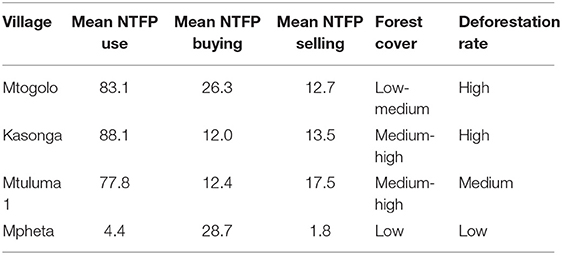
Table 9. Comparison of mean use, buying, and selling of NTFPs across the study villages in relation to forest cover and deforestation status.
In relation to deforestation status, there were variations in the proportion of households involved in selling NTFPs within the villages. Mtogolo and Kasonga had at least three products with participation of more than one-quarter of the households, while Mtuluma 1 had two products and Mpheta had none. Another notable trend was the selling of bushmeat which was done in Kasonga and Mtuluma 1 villages only, a clear indication of the low forest status in the other two villages.
The importance of easy availability as a prerequisite for trade was revealed in it being ranked the most important attribute that traders considered when deciding which NTFPs to sell (Table 10). High quantities was the second ranked criterion and ease of harvesting the next. This was based on the logic that even if the products could be available and accessible the amounts to be harvested will determine the amount of cash income that could be generated after sales. Thus, locations experiencing deforestation are likely to have reduced availability of some NTFPs, thereby limiting opportunities for trade in local NTFPs.
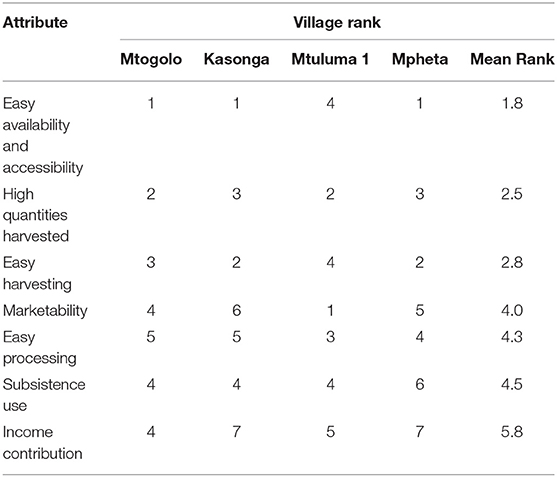
Table 10. Attributes which influence a household's decision on type of NTFP to sell (ranking 1 = high; 7 = low).
Discussion
This study has revealed the considerable variation in the use, purchase and sale of locally sourced of NTFPs across the four villages. This is likely to be partially due to the differences in forest cover and hence proximity and availability of particular NTFPs.
Household Use of NTFPs
Across the four villages every household used at least one NTFP. Firewood was used to some extent as a source of domestic energy by every household, but several other NTFPs were used by >80% of households, including thatch grass, wild fruits, wild vegetables, rope fiber, bamboo and timber for building, and fencing. Other than rope fiber, this inventory of widely used NTFPs corresponds with those from other household surveys in southern African countries such as Malawi (Kamanga et al., 2009), South Africa (Shackleton and Shackleton, 2004), and Zimbabwe (Campbell et al., 2002). Such extensive use reflects the cultural and utilitarian demand for NTFPs in the region, and for many households, their high level of dependence on wild products (Angelsen et al., 2014). However, local accessibility can influence the extent to which specific NTFPs are used as well as the means by which they are procured, notably via purchase or self-collection or a combination of both. For example, use of bushmeat was lowest in Mpheta, most likely because of its low availability due to a lack of forests and nearby protected areas. Similarly, the use of edible orchids was greatest in Kasonga, which is where they were found, and consequently the extent of buying of edible orchids in Kasonga was quite low. Thus, local abundance supports self-collection and undermines the prospects for significant markets within a village, but local scarcity of particular NTFPs is regarded as an important catalyst for markets.
Trade in NTFPs
Overall, there was significant market activity, with 39% of households selling one or more NTFP on a regular or ad hoc basis. This is markedly higher than the 22% reported by Paumgarten and Shackleton (2009) for two villages in South Africa. Differences observed here are linked to a number of factors (e.g., types of markets, pricing, demand and supply), which this study did not address in detail. Results within the villages indicate 77% of households in Mtogolo, 62% in Mtuluma 1, 25% in Kasonga, and 2% in Mpheta participated in NTFP trade. Thus, the village with the lowest forest cover, Mpheta, had the lowest number of households involved in trading NTFPs. However, involvement in NTFP trade is shaped at various scales, from the individual, to the household, within the village and wider, regional context. For example, mushroom trade in Mpheta was largely the domain of males allegedly because of the considerable distance required to reach the harvest sites. Previous work has highlighted gender roles (Marshall et al., 2006a; Kanmegne et al., 2007; Ingram et al., 2014) as well as the influence of household wealth. For example, a greater proportion of richer households are likely to buy some or all of the NTFPs that they use compared to poorer households (Shackleton and Shackleton, 2006), and poorer households are more likely to sell one or more NTFPs (Shackleton and Shackleton, 2006; Christensen et al., 2008).
Different pictures emerge depending on the analytical focus. A sectoral analysis of a single NTFP, such as wild fruits or thatch grass underestimates the proportion of households engaged in NTFP trade, and potentially the incomes earned from NTFP trade. The latter is a consequence of both not disaggregating the nature of the trade and income of specialized traders from occasional ones and also overlooking that some households trade in multiple NTFPs. With respect to the first, aggregating ad hoc and specialist, more or less full-time traders means that the poverty alleviation potential of NTFP trade is misjudged. Mean monthly or annual incomes from NTFP trade were generally low and for most participants below the poverty line. However, if returns were expressed as per hour worked in the NTFP sector, then the aggregation of occasional and more full-time traders is possible. This revealed that for many, the returns to labor were well-above national minimum wages leading to very different conclusions regarding the importance of the NTFP sector, as argued by Shackleton and Pullanikkatil (2018).
A sectoral analysis of specific NTFP value chains also neglects that many participants trade in more than one NTFP product. In this study, almost two-thirds (64%) of those selling NTFPs sold more than one product, and generally the more products sold the greater the annual cash income from NTFPs. The benefits of trading more than one NTFP are not just about increasing income, although clearly that is likely to be paramount. It is also likely to spread the risk if the supply or price of one NTFP temporarily declines. It may also diversify skills at the household level. However, it will require greater knowledge of sources, markets and prices.
NTFP Market Chains
The value chains of the four products were short and simple. Consequently, each operated in the same way and included similar functions, i.e., collection, transport, processing, direct sales, and sales through intermediaries. These are common stages in value chains (Marshall et al., 2006a), but in short chains there is no, or only limited, differentiation between different actors; the same person engages in most or all of the stages. The chains were short and did not reach national markets because of (i) low value addition with most of the products sold in raw form, (ii) unwillingness of the buyers to pay more for products, probably because of their raw form, (iii) perishability of some products, and (iv) product marketing networks that were not well-developed compared with those for agricultural produce from the same region. Village location and deforestation status appeared to have no influence of the length of the value chain.
Although most traders occupied all positions in the market chain there were a few other actors. These included the Forestry Department which provided expertise and guidance in forest management and hence the supply of and access to NTFPs. Former actors were also encountered as some traders had moved out due to challenges associated with NTFP trade. Also, non-participants were noted as more than half of the households indicated they did not engage in NTFP trade, supporting the descriptions by Bolwig et al. (2011). The study further revealed the absence of vertical and horizontal coordination within the value chain among different actors at different or same nodes. NTFP traders were usually engaged in one-off market transactions, as individuals. There was no bulking of the products for sale and no sale contracts with the buyers were established to promote certainty about future revenue (Bolwig et al., 2011; Mitchell and Coles, 2011). Collective action is a requirement for increasing the vertical coordination (Mitchell and Coles, 2011). However, despite the benefits, vertical coordination may be difficult, and costly to achieve because it involves higher performance requirements, such as quality checks and guarantees (Mitchell and Coles, 2011).
Challenges Associated With NTFP Trade
The returns associated with NTFP trade are affected by low market prices and the types of markets. For example, Malleson et al. (2014) reported that in Ghana, Cameroon and Nigeria, prices are subject to external market forces. High prices would result in poor sales regardless of quality since not many consumers were willing to pay adequately for quality NTFPs (Kilchling et al., 2009). Types of markets influence prices and this has been reported as a common challenge to NTFP traders in India, South Africa, Bolivia and Mexico (te Velde et al., 2006; Shackleton et al., 2011; Mahapatra and Shackleton, 2012; Saha and Sundriyal, 2012). Adam et al. (2013) found that cash income received from NTFPs was affected by market saturation due to a limited number of markets. Additionally, the short shelf-life of some products exposed the traders to exploitation when demand was low and supply high during the peak season (Belcher and Schreckenberg, 2007; Jensen, 2009). The need for households to acquire knowledge for certain products (i.e., mushrooms, edible orchids) to be involved in the trade was a hindrance to some who lacked such knowledge and the means to acquire it. This supports findings from Malawi, Tanzania and elsewhere that there was need for knowledge transfer from the experienced and typically elderly, to newcomers and the youth regarding identifying and harvesting certain NTFPs (Challe and Struik, 2008; Challe and Price, 2009; Kasulo et al., 2009), most likely via vertical and oblique transmission pathways (Ruiz-Mallén et al., 2013). Knowledge of NTFP names, uses and ecology is generally regarded as declining in many settings as a result of acculturation and urbanization (Van den Boog et al., 2017). Higher rates of decline are common amongst communities with increasing links to urban centers, market economies, participation in externally designed formal schooling systems and increasing affluence which is associated with a decline in reliance on NTFPs (Pilgrim et al., 2008; Barreau et al., 2016; Aswani et al., 2018).
The respondents perceived that there had been a decline in the availability of most NTFPs over the last decade although there were some differences between villages. In all the study villages land cover/use change resulted in the reduction of the availability, with deforestation as the driver due to clearing of new land for settlement and agricultural production. This corroborates the findings by Openshaw (2010) and Pullanikkatil et al. (2019) who found that natural forests and grasslands in Malawi were being converted to agricultural production and settlements. Therefore, low amounts were harvested by traders for most of NTFPs due to scarcity of the resources, which in turn affected the returns to labor. Adam et al. (2013) reported similar results in the drylands of Sudan. The small quantities available pushed some households to disengage from NTFP trade.
In conclusion, this study has shown that both use and trade in a diversity of NTFPs is widespread in the four sample villages. Moreover, absolute incomes from NTFP trade were modest, but less so when expressed as returns to labor, with hourly returns generally surpassing minimum wage prescriptions. Lastly, the patterns of use and especially trade are partially shaped by the nature of the surrounding environment and especially the ease of collection and relative abundance to permit investment in the trade. Thus, deforestation is likely to result in altered patterns of NTFP use and trade, but has rarely been considered in deforestation studies. Additionally, the nature and quality of local environments has rarely been factored into NTFP studies, especially those examining market chains and incomes.
Data Availability Statement
The datasets generated for this study are available on request to the corresponding author.
Ethics Statement
This study was carried out in accordance with the research ethics guidelines of Rhodes University and approved in advance by the then ethics committee of the Dept of Environmental Science. Additionally, this study comprised part of the broader ASSETS project for which ethics approval was provided from the University of Southampton's Ethics Committee (Ref 8717).
Author Contributions
All authors listed have made a substantial, direct and intellectual contribution to the work, and approved it for publication.
Funding
The study took place under the Attaining Sustainable Services from Ecosystems using Trade-off Scenarios project (NE-J002267-1), funded by the UK's Ecosystem Services for Poverty Alleviation (ESPA) programme.
Conflict of Interest
The authors declare that the research was conducted in the absence of any commercial or financial relationships that could be construed as a potential conflict of interest.
References
Abtew, A. A., Pretzsch, J., Mohmoud, T. E., and Adam, Y. O. (2012). Commodity chain of frankincense from the dry woodlands of Nuba Mountains, South Kordofan State, Sudan. Small-Scale Forest. 11, 365–388. doi: 10.1007/s11842-011-9189-4
Adam, Y., Pretzsch, J., and Pattenella, D. (2013). Contribution of non-timber forest products livelihoods strategies to rural development in drylands of Sudan: potentials and failures. Agric. Syst. 117, 90–97. doi: 10.1016/j.agsy.2012.12.008
Angelsen, A., Jagger, P., Babigumira, R., Belcher, B., Hogarth, N. J., Bauch, S., et al. (2014). Environmental income and rural livelihoods: a global-comparative analysis. World Dev. 64, S12–S28. doi: 10.1016/j.worlddev.2014.03.006
Aswani, S., Lemahieu, A., and Sauer, W. (2018). Global trends of local ecological knowledge and future implications. PLoS ONE 13:e0195440. doi: 10.1371/journal.pone.0195440
Awono, A., Ndoye, O., and Preece, L. (2010). Empowering women's capacity for improved livelihoods in non-timber forest product trade in Cameroon. Int. J. Soc. Forest. 3, 151–163.
Bandyopadhyay, S., Shyamsundar, P., and Baccini, A. (2011). Forests, biomass use and poverty in Malawi. Ecol. Econom. 70, 2461–2471. doi: 10.1016/j.ecolecon.2011.08.003
Barreau, A., Ibarra, J. T., Wyndham, F. S., Rojas, A., and Kozak, R. A. (2016). How can we teach our children if we cannot access the forest? Generational change in Mapuche knowledge of wild edible plants in Andean Temperate ecosystems of Chile. J. Ethnobiol. 36, 412–432. doi: 10.2993/0278-0771-36.2.412
Belcher, B. (1998). “A production to consumption systems approach: lessons from the bamboo and rattan sectors in Asia,” in Incomes From the Forest: Methods for the Development and Conservation of Forest Products for Local Communities, eds E. Wollenberg and A. Ingles (Bogor: Centre for International Forestry Research, 56–84.
Belcher, B., and Schreckenberg, K. (2007). Commercialisation of non-timber forest products: a reality check. Dev. Policy Rev. 25, 355–377. doi: 10.1111/j.1467-7679.2007.00374.x
Bolwig, S., Riisgaard, S., du Toit, A., and Halberg, N. (2011). “A methodology for intergrating development concerns into value chain analysis and interventions,” in Markets and Rural Poverty Upgrading in Value Chains, eds J. Mitchell and C. Coles, C (London: Earthscan, 21–45.
Campbell, B. M., Jeffrey, S., Kozanayi, W., Luckert, M., Mutamba, M., and Zindi, C. (2002). Household Livelihoods in Semi-Arid Regions: Options and Constraints. Bogor: CIFOR.
Challe, J., and Struik, P. (2008). The impact on orchid species abundance of gathering their edible tubers by HIV/AIDS orphans: a case of three villages in the Southern Highlands of Tanzania. Wagen. J. Life Sci. 56, 261–279. doi: 10.1016/S1573-5214(08)80011-5
Challe, J. F., and Price, L. L. (2009). Endangered edible orchids and vulnerable gatherers in the context of HIV/AIDS in the Southern Highlands of Tanzania. J. Ethnobiol. Ethnomed. 5:41. doi: 10.1186/1746-4269-5-41
Christensen, M., Bhattarai, S., Devkota, S., and Larsen, H. O. (2008). Collection and use of wild edible fungi in nepal. Econ. Bot. 62, 12–23. doi: 10.1007/s12231-007-9000-9
Cunningham, A. B. (2011). “Non-timber products and markets: Lessons for export-oriented enterprise development from Africa,” in Non-timber Forest Products in the Global Context, eds S. E. Shackleton, C. M. Shackleton and P. Shanley (Springer, Heidelberg), 83–106. doi: 10.1007/978-3-642-17983-9_4
De Sousa, F. F., Vieira-de Silva, C., and Barros, F. B. (2018). The (in)visible market of miriti (Mauritia flexuosa L.f.) fruits, the “winter acai”, in Amazonian riverine communities of Abaetetuba, Northern Brazil. Glob. Ecol. Conserv. 14:e00393. doi: 10.1016/j.gecco.2018.e00393
Heinen, J. T., and Shrestha-Acharya, R. (2011). The non-timber forest products sector in Nepal: Emerging policy issues in plant conservation and utilization for sustainable development. J. Sust. Forest. 30, 543–563. doi: 10.1080/10549811.2011.567376
Ickowitz, A., Powell, B., Salim, A. M., and Sunderland, T. C. H. (2013). Dietary quality and tree cover in Africa. Glob. Environ. Change 24, 287–294. doi: 10.1016/j.gloenvcha.2013.12.001
Ingram, V., Schure, J., Tieguhong, J. C., Ndoye, O., Awono, A., and Iponga, D. M. (2014). Gender implications of forest product value chains in the Congo basin. Forest. Trees Livelihoods 23, 67–86. doi: 10.1080/14728028.2014.887610
Jensen, A. (2009). Valuation of non-timber forest products value chains. Forest Policy Econ. 11, 34–41. doi: 10.1016/j.forpol.2008.08.002
Kamanga, P., Vedeld, P., and Sjaatstad, E. (2009). Forest incomes and rural livelihoods in Chiradzulu District, Malawi. Ecol. Econ. 68, 613–624. doi: 10.1016/j.ecolecon.2008.08.018
Kanmegne, J., Oyono Belinga, J. M., Degrande, A., Tchoundjeu, Z., and Tiki Manga, T. (2007). Gender analysis in the commercialisation of Gnetum africanum/buchholzianum in the Lékjé division in Cameroon. J. Food Agricul. Environ. 5, 243–247.
Kasulo, V., Mwabumba, L., and Munthali, C. (2009). A review of edible orchids in Malawi. J. Horticult. Forest. 1, 133–139.
Kilchling, P., Hansmann, R., and Seeland, K. (2009). Demand for non-timber forest products: survey of urban consumers and sellers in Switzerland. Forest Policy Econ. 11, 294–300. doi: 10.1016/j.forpol.2009.05.003
Lundy, M., Gottret, M. V., Ostertag, C., Best, R., and Ferris, S. (2008). Participatory Market Chain Analysis for Smallholder Producers. Baltimore: Catholic Relief Services.
Mahapatra, A., and Shackleton, C. (2012). Exploring the relationship between trade in natural products, cash income and livelihoods in tropical forest regions of Eastern India. Int. Forest. Rev. 14, 62–73. doi: 10.1505/146554812799973217
Malleson, R., Asaha, S., Egot, M., Kshatriya, M., Marshall, E., Obeng-Okra, K., et al. (2014). Non-timber forest products income from forest landscapes of Cameroon, Ghana and Nigeria - an incidental or integral contribution to sustaining rural livelihoods? Int. Forest. Rev. 16, 261–277. doi: 10.1505/146554814812572449
Marshall, E., Schreckenberg, K., and Newton, A. (2006a). Commercialisation of Non-timber Forest Products. Factors influencing success: Lessons learned from Mexico and Bolivia and policy implications for decision makers. Cambridge: UNEP World Conservation Monitoring Centre.
Marshall, E., Schreckenberg, K., and Newton, A. (2006b). Non-timber Forest Products Commercialisation Research Methods: Practical Tools For Researching Successful NTFP Commercialisation: A Methods Manual. London: DFID.
Maseko, H., Shackleton, C. M., Nagoli, J., and Pullanikkatil, D. (2017). Children and wild foods in the context of deforestation in rural Malawi. Hum. Ecol. 45, 795–807. doi: 10.1007/s10745-017-9956-8
Matias, D. M., Tambo, J. A., Stellmacher, T., Borgemeister, C., and von Wehrden, H. (2018). Commercializing traditional non-timber forest products: An integrated value chain analysis of honey from giant honey bees in Palawan, Philippines. Forest Policy Econ. 97, 223–231. doi: 10.1016/j.forpol.2018.10.009
Meijer, S. S., Sileshi, G. W., Catacutan, D., and Nieuwenhuis, M. (2016). Agroforestry and deforestation in Malawi: inter-linkages between attitudes, beliefs and behaviours. Agroforest. Syst. 90, 645–658. doi: 10.1007/s10457-015-9844-4
Mitchell, J., and Coles, C. (2011). Market and Rural Poverty: Upgrading in Value Chain, 1st Edn. London; Washington, DC: Earthscan.
Mitchell, J., Shepherd, A., and Keane, J. (2011). “An Introduction,” in Markets and Rural Poverty, Upgrading in Value Chains, eds J. Mitchell and C. Coles (London: Earthscan, 1–20.
Ndumbe, L. N., Ingram, V., Tchamba, M., and Nya, S. (2019). From trees to money: the contribution of njansang (Ricinodendron huedelotii) products to value chain stakeholder's financial assets in the South West region of Cameroon. Forests Trees Livelihoods 28, 52–67. doi: 10.1080/14728028.2018.1559107
Neumann, R., and Hirsch, E. (2000). Commercialisation of Non-timber Forest Products: Review and Analysis of Research. Bogor: Center for International Forestry Research.
Nkem, J., Kalame, F. B., Idiniba, M., Somorin, O. F., Ndoye, O., and Awono, A. (2010). Shaping forest safety nets with markets: Adaptation to climate change under changing roles of tropical forests in Congo Basin. Environ. Sci. Policy 13, 498–508. doi: 10.1016/j.envsci.2010.06.004
Openshaw, K. (2010). Biomass energy: Employment generation and its contribution to poverty alleviation. Biomass Bioenergy 34, 365–378. doi: 10.1016/j.biombioe.2009.11.008
Paumgarten, F., and Shackleton, C. (2009). Wealth differentiation in household use and trade in non-timber forest products in South Africa. Ecol. Econ. 68, 2950–2959. doi: 10.1016/j.ecolecon.2009.06.013
Pilgrim, S. E., Cullen, L. C., Smith, D. J., and Pretty, J. (2008). Ecological knowledge is lost in wealthier communities and countries. Environ. Sci. Technol. 42, 1004–1009. doi: 10.1021/es070837v
Poppy, G., Chiotha, S., Eigenbrod, F., Harvey, C., Honzak, M., Hudson, M., et al. (2014). Understanding food security in a perfect storm: An ecosystem services approach. Philosoph. Trans. R. Soc. B. 369:20120288. doi: 10.1098/rstb.2012.0288
Pullanikkatil, D., Mograbi, P. J., Palamuleni, L., Ruhiiga, T., and Shackleton, C. M. (2019). Unsustainable Trade-Offs: Ecosystem Services in a Rapidly Changing Likangala River Catchment in Southern Malawi. Environment, Development and Sustainability.
Putzel, L., Kelly, A. B., Cerutti, P. O., and Artati, Y. (2015). Formalization as development in land and natural resource policy. Soc. Nat. Resour. 28, 453–472. doi: 10.1080/08941920.2015.1014608
Ruiz-Mallén, I., Morsello, C., Reyes-garcía, V., and Barros Marcondes De Faria, R. (2013). Children's use of time and traditional ecological learning. A case study in two Amazonian indigenous societies. Learn. Individ. Differ. 27, 213–222. doi: 10.1016/j.lindif.2012.12.012
Saha, D., and Sundriyal, R. (2012). Utilisation of non-timber forest products in humid tropics: Implications for management and livelihood. Forest Policy Econ. 14, 28–40. doi: 10.1016/j.forpol.2011.07.008
Shackleton, C., and Shackleton, S. (2004). The importance of non-timber forest products in rural livelihood security and safety net: a review of evidence from South Africa. South Africa J. Sci. 100, 658–664.
Shackleton, C. M. (2015). “Multiple roles of non-timber forest products in ecologies, economies and livelihoods,” in Routledge Handbook of Forest Ecology, eds K. Peh, R. Corlett, and Y. Bergeron (London: Routledge, 559–570.
Shackleton, C. M., and Pandey, A. K. (2014). Positioning non-timber forest products on the development agenda. Forest Policy Econ. 38, 1–7. doi: 10.1016/j.forpol.2013.07.004
Shackleton, C. M., and Pullanikkatil, D. (2018). “Considering the links between non-timber forest products and poverty alleviation,” in Moving Out of Poverty Through Using Forest Products: Personal Stories, eds D. Pullanikkatil and C. M. Shackleton. (Heidelberg: Springer), 15–28. doi: 10.1007/978-3-319-75580-9_2
Shackleton, C. M., and Shackleton, S. (2006). Household wealth status and natural resources use in the Kat River Valley, South Africa. Ecol. Econ. 57, 306–317. doi: 10.1016/j.ecolecon.2005.04.011
Shackleton, S., Paumgarten, F., Kassa, H., Husselman, M., and Zida, M. (2011). Opportunities for enhancing poor women's socio-economic empowerment in the value chains of three Africa Non-Timber Forest Products (NTFPs). Int. Forest. Rev. 13, 136–151. doi: 10.1505/146554811797406642
Shackleton, S., Shanley, P., and Ndoye, O. (2007). Invisible but viable: local markets for non-timber forest products. Int. Forest. Rev. 9, 697–712. doi: 10.1505/ifor.9.3.697
Shackleton, S. E., Campbell, B., Lotz-Sisitka, H., and Shackleton, C. M. (2008). Links between the local trade in natural products, livelihoods and poverty alleviation in a semi-arid region of South Africa. World Dev. 36, 505–526. doi: 10.1016/j.worlddev.2007.03.003
te Velde, D., Rushton, J., Schreckenberg, K., Marshall, E., Edouard, F., Newton, A., and Arancibia, E. (2006). Entrepreneurship in value chains of non-timber forest products. Forest Policy Econ. 8, 725–741. doi: 10.1016/j.forpol.2005.06.010
Torres, P. C., Morsello, C., Parry, L., Barlow, J., Ferreira, J., Gardner, T., et al. (2018). Landscape correlates of bushmeat consumption and hunting in a post-frontier Amazonian region. Environ. Conserv. 48, 315–323. doi: 10.1017/S0376892917000510
Van den Boog, T., van Andel, T., and Bulkan, J. (2017). Indigenous children's knowledge about non-timber forest products in Suriname. Econ. Bot. 71, 361–373. doi: 10.1007/s12231-017-9400-4
Vedeld, P., Angelsen, A., Bojö, J., Sjaastad, E., and Kobugabe Berg, G. (2007). Forest environmental incomes and the rural poor. Forest Policy Econ. 9, 869–879. doi: 10.1016/j.forpol.2006.05.008
Welford, L., and le Breton, G. (2008). Bridging the gap: Phytotrade Africa's experience of the certification of natural products. Forest. Trees Livelihoods 18, 69–79. doi: 10.1080/14728028.2008.9752618
Wynberg, R., and van Niekerk, J. (2014). “Governance, equity and sustainability in non-timber forest product value chains,” in Governance for Justice and Environmental Sustainability: Lessons Across Natural Resource Sectors in Sub-Saharan Africa, eds M. Sowman and R. Wynberg, R (Earthscan/Routledge), 279–304. doi: 10.4324/9780203120880-14
Keywords: deforestation, income, Malawi, non-timber forest products, selling, trade
Citation: Mahonya S, Shackleton CM and Schreckenberg K (2019) Non-timber Forest Product Use and Market Chains Along a Deforestation Gradient in Southwest Malawi. Front. For. Glob. Change 2:71. doi: 10.3389/ffgc.2019.00071
Received: 01 April 2019; Accepted: 23 October 2019;
Published: 08 November 2019.
Edited by:
Verina Jane Ingram, Wageningen University and Research, NetherlandsReviewed by:
Ann Degrande, World Agroforestry, CameroonRainer Willi Bussmann, Saving Knowledge, Bolivia
Copyright © 2019 Mahonya, Shackleton and Schreckenberg. This is an open-access article distributed under the terms of the Creative Commons Attribution License (CC BY). The use, distribution or reproduction in other forums is permitted, provided the original author(s) and the copyright owner(s) are credited and that the original publication in this journal is cited, in accordance with accepted academic practice. No use, distribution or reproduction is permitted which does not comply with these terms.
*Correspondence: Charlie M. Shackleton, Yy5zaGFja2xldG9uQHJ1LmFjLnph
 Sophie Mahonya
Sophie Mahonya Charlie M. Shackleton
Charlie M. Shackleton Kate Schreckenberg
Kate Schreckenberg
